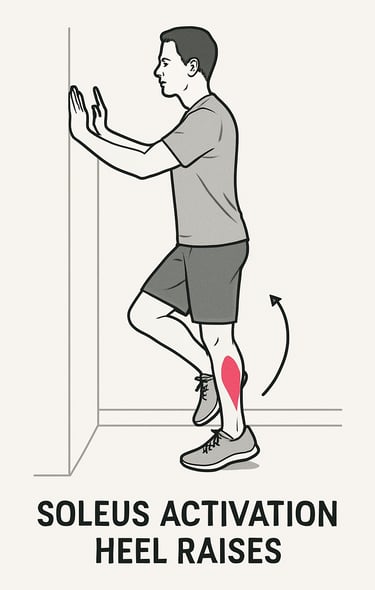🧵 The Secret Sugar-Burning Muscle: How the Soleus Can Transform Your Metabolic Health
🌾 Why This Matters in India Today India is rapidly becoming the diabetes capital of the world. With high-carb diets (like rice, chapati, poha, and idli) and increasingly sedentary lifestyles, more people are facing challenges like: High fasting/post-meal blood sugar
MOBILITY
Ravisankar Lakshminarayanan
5/30/20253 min read


🧵 The Secret Sugar-Burning Muscle: How the Soleus Can Transform Your Metabolic Health
🌾 Why This Matters in India Today
India is rapidly becoming the diabetes capital of the world. With high-carb diets (like rice, chapati, poha, and idli) and increasingly sedentary lifestyles, more people are facing challenges like:
High fasting/post-meal blood sugar
Insulin resistance
Pre-diabetes and Type 2 diabetes
Fatigue and metabolic slowdown
But what if we told you there’s a small, often ignored muscle in your leg that could help manage your blood sugar naturally — even while sitting?
Enter: The Soleus Muscle
🧬 What is the Soleus Muscle?
The soleus is a deep calf muscle underneath the more visible gastrocnemius. It’s responsible for maintaining posture and supporting standing and walking.
But recent research shows it also has a surprising power: burning glucose without needing insulin.
🔬 What the Science Says
✳️ Groundbreaking Research – University of Houston, 2022
Researchers discovered a simple seated movement called the “Soleus Pushup” or “Soleus Heel Raise” activates this muscle in a special way.
Key findings:
🔻 52% reduction in blood sugar spike after consuming a sugary drink.
🔥 175% increase in fat metabolism, even during prolonged sitting.
✅ This activation works independently of insulin, which is especially helpful for those with insulin resistance or diabetes.
The magic lies in the AMPK (AMP-activated protein kinase) pathway, which promotes glucose uptake directly into the muscle.
🇮🇳 Why This is Crucial for Indians
Our diets — especially in South India — are rich in carbs:
Idli, dosa, rice, roti, upma, pongal, poha…
Often consumed with limited fiber and protein.
While these foods are cultural staples, they cause glucose spikes that over time may lead to insulin resistance. The soleus heel raise offers a powerful, drug-free solution to help our bodies manage this surge more effectively.
🧬 Why the Soleus Muscle Requires Glucose
The soleus muscle is always active, especially in maintaining posture and aiding circulation. It consists primarily of slow-twitch (Type I) fibers, which use aerobic metabolism and prefer glucose and fat as fuel sources.
Because of its high mitochondrial density and low fatigue, the soleus:
Burns glucose efficiently
Works continuously, even while sitting
Acts as a “glucose sink”, especially in insulin-resistant individuals
And most importantly:
It can absorb glucose without insulin via the AMPK (AMP-activated protein kinase) pathway
This makes it uniquely positioned to help manage blood sugar, especially in sedentary individuals or those with diabetes.
⚡ How the Soleus Gets Glucose Before Insulin Acts
After you eat, glucose enters the bloodstream. While most muscles wait for insulin to trigger glucose uptake, the soleus can pull glucose directly from the blood through AMPK activation when it’s contracting (even mildly).
🧠 Think of it this way:
"Blood delivers glucose to all tissues, but the soleus doesn’t wait for insulin to unlock the door — it opens it on its own."
This means that while the rest of the body is waiting for insulin, the soleus is already at work, reducing glucose levels quickly and efficiently.
🏃♂️ How to Do the Soleus Heel Raise
You can do it while sitting — at work, in a bus, during TV time.
✅ Steps:
Sit comfortably on a chair.
Keep both feet flat on the ground.
Slowly lift the heel up while keeping the toes and front foot planted.
Let the heel drop passively.
Repeat slowly and rhythmically for 5–10 minutes per session.
🎯 Daily Recommendation:
2–3 sessions per day (after meals or during long sitting).
Target 30–60 minutes total across the day (can be broken into short bursts).
🧠 Health Benefits
BenefitWhy It Matters🔄 Lower Blood SugarBlunts post-meal glucose spikes💪 Insulin-IndependentWorks even if you're insulin resistant🔥 Fat Metabolism BoostHelps reduce belly fat & improve energy🏋️ Stress-Free ActivityCan be done passively, seated⏳ Supports LongevityImproves metabolic flexibility & circulation
🍛 Combine with Smart Nutrition
The effect multiplies when you:
Pair it with low-carb, high-protein, fiber-rich meals (e.g., NaatiBru's nutrition plans)
Eat protein-rich breakfast (like moong dal chilla, sprouts idli, or paneer poha)
Stay hydrated and get adequate sleep
🗞️ Real-Life Example: Morning Routine for Diabetic Users
TimeAction7:00 AMWake up, warm water7:30 AM5 mins of Soleus Heel Raises (seated)8:00 AMHigh-protein breakfast (e.g., 2 sprouts idli + moringa chutney)9:00 AM5 mins of Soleus Heel RaisesAfter lunch/dinnerRepeat the movement again for 5–10 minutes
📣 From NaatiBru to You
At NaatiBru.com, we’re not just about food. We focus on empowering daily habits that support sustainable health. Our wellness plans always include:
Mobility routines like the Soleus Heel Raise
Nutrition tailored for blood sugar stability
Real-world, easy-to-follow tips that anyone can practice
Whether you’re 25 or 65, a badminton player or a working professional — this small move can make a big impact.
🛑 No Excuse Zone: Who Can Do This?
✅ Senior citizens
✅ Office-goers
✅ People with knee pain (non-weight bearing)
✅ Overweight and diabetic individuals
✅ Housewives and caregivers
✅ People recovering from metabolic fatigue
🌟 Final Takeaway
“You don’t need to run to burn sugar. Just move the right muscle while sitting.”
The soleus heel raise is a hidden gem in our fight against modern-day lifestyle diseases — easy, practical, and rooted in science.


Follow us
platanoorganic6@gmail.com
+919019754079
© 2025. All rights reserved.
FSSAI License no : 21223192000415
Platano Organic Foods
